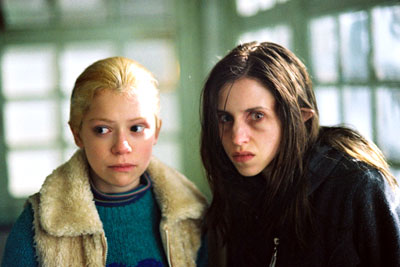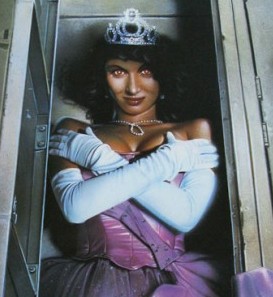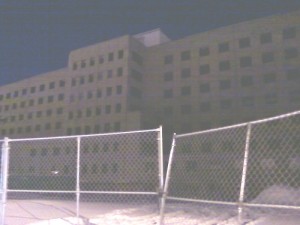Grim cities vie for horror film infamy
Posted on October 27, 2013 By Rob Drinkwater Entertainment, Film, Front Slider, life

From Ginger Snaps 2, shot in Edmonton
The organizers of Edmonton’s horror film festival, DEDfest, never pass up an opportunity to promote the city to its visiting VIPs as an ideal place to shoot their next slash-fest or zombie-romp.
But like the horny camp counsellors at Camp Crystal Lake in Friday the 13th, Edmonton isn’t alone. There are other cities lurking out there, trying to lure and capture horror filmmakers in the same way Edmonton has been attempting in the last two years.
Buffalo, New York, is one of those cities. It features a wide variety of derelict or empty buildings owing to its once-booming past as a stop on the Erie Canal. The canal was dealt a fatal blow by the construction of the St. Lawrence Seaway, leaving behind remnants of a once larger and grander city, complete with empty grain mills, ships, and an eerie old railway station that provide the perfect backdrop for legions of corpses to chase comely teenagers. Buffalo has even also hosted its own horror movie festival, called “Buffalo Screams.” The festival is expanding and has changed its name to “Buffalo Dreams” to accommodate additional genres, but there’s no shortage of blood on the screens.
Canadian scream queen Debbie Rochon, who has turned her hand from horror-acting to horror-directing, recently filmed a revenge-themed movie in Buffalo called Model Hunger, which is now in post-production.
“I don’t know if there’s any correlation, but the number of years the festival has been running is about the same as when production ramped up,” says filmmaker Greg Lamberson, founder and co-director of Buffalo Dreams. “The more movies you have shot in your city, the more filmmakers know it can be done. It’s like having a resume.”
Out for blood

From Prom Night II, shot in Edmonton
The Edmonton film office announced early last year a plan to target low-budget horror filmmakers. Touting creepy buildings, spooky forests, long and dark winter nights as well as financial incentives, the plan was to market the city as a place that’s different from Calgary and Southern Alberta, which typically attracts Westerns.
Who else besides Buffalo and Edmonton are out for blood? A headline from The Herald in Scotland in May 2012 reads, “Scotland is Hoping to Make a Killing.” Closer to home, Moose Jaw, Saskatchewan has punched well above its weight class in the movie business for a number of years. (Business appears to be drying up there since the government of Premier Brad Wall cancelled the province’s film tax credit.)
DEDfest plays an important role in Edmonton’s strategy by bringing directors here to screen their movies. In 2012, the festival brought in Michael Biehn, who was in Terminator and Aliens, and his wife, Jennifer Blanc-Biehn, for a screening of his directorial debut, a grindhouse homage called The Victim.
Biehn and his wife now make low-budget horror movies and while here, they toured Alberta Hospital and the former Celanese petrochemical plant for possible shoot locations for upcoming movies.
This year, DEDfest brought in Bobcat Goldthwait to screen his found-footage Bigfoot film, Willow Creek.
“Michael and Jennifer Biehn, for example, have Edmonton on their radar only because of DEDfest,” said Edmonton’s film commissioner Brad Stromberg, via email. “That ‘fest brought them here, we toured them around, showed them locations, talked about crew and incentives. They liked what they saw. Their next step/focus is the raising of funds, confirming of deals and all other matters connected to production. We’re on their radar when they’re ready to shoot.”

The creepy abandoned Charles Camsell Hospital
Derek Clayton of DEDfest, who is also a filmmaker, says the job of promoting Edmonton involves more than just bringing VIPs here. He recently went to Austin for the Fantastic Fest film festival to promote “The Last Video Store,” which he produced with directors Timothy Rutherford and Cody Kennedy. They had to scrape money together to get there. Grants takes time and filmmakers often only get a few weeks notice that they’ve been selected as festival entries. Stromberg helped find some money, Clayton says, and Bill Evans at AMPIA helped with a bit more.
Clayton says he and Rutherford ended up meeting Elijah Wood, sat with Keanu Reeves and went skeet-shooting with them. What did they talk about? Lots of stuff. But Clayton says he and Rutherford made sure to talk up Edmonton.
“Sometimes people sitting at a desk don’t realize that those are the kind of connections people make,” Clayton says. “We pitch what we’re doing and let the work speak for itself.”
Incentives, of course, also play a big role. Production companies in New York can receive a credit for up to 30 per cent of certain costs incurred in the state, as well as up to 35 per cent of production costs if they are incurred in Upstate New York.
Tim Clark, the film commissioner for western New York, says the state passed another incentive which comes into effect in 2015 which will rebate an additional five per cent for labour costs in certain regions, which will include Buffalo.

Bobcat Goldthwait, comic turned horror filmmaker
“Canada kicked our ass for so many years with these incentives,” Clark says, noting the city helps out in other ways, too. “We don’t charge for police officers or to close streets, we just make it part of our economic development. They’re putting money in our hotel rooms and we get the kind of world publicity we could never afford.”
Stromberg says Alberta’s incentives are particularly generous because they don’t just apply to wages. He says accommodations, equipment rentals, transportation, props, as well as salaries for Albertans can qualify for up to 30 per cent re-imbursement from the province.
Stromberg explains, “The Disneys, Universals, Hallmarks and Sonys have divisions dedicated to knowing how incentives vary from region to region and how much they’ll ‘get back’ if they do their next film in B.C. or New Mexico or Hungary or Edmonton.”
Clayton says one of the things that Edmonton has going for it is that there is money in the wallets of fans. In some cases, low-budget local filmmakers are able to crowd-source their productions or even get financing from their friends. The strong economy could have a downside, however. Old buildings that provide the perfect atmosphere for horror movies are also ripe for redevelopment. The empty Celanese factory is coming down. There was also interest from filmmakers in using the former Charles Camsell Hospital, but the inside of the building has been gutted.
Stromberg says, “In horror, good locations don’t always remain.”













